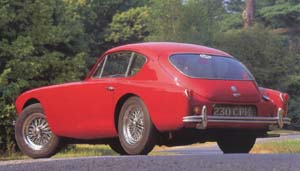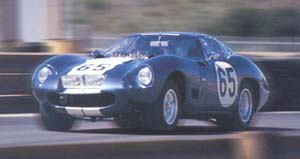The two-seater AC Aceca, the fastback version of the AC Ace roadster, was powered by the Ace 6-cylinder engine. AC built about 151 of the handsome coupes. AC also produced the AC Greyhound, a four-seater version of the AC Aceca with revised front end styling and the Bristol engine.
AC also built a one-off AC Cobra Coupe to run in the 1964 Le Mans, the race won by Bondurant and Gurney in the Daytona Coupe. The AC Coupe was beautiful, sleek, and fast. On June 10, 1964, in the early morning hours, AC testers attained a speed of 185 mph on Britainís M1 no-speed-limit super highway. Alas, a reporter was present and the ensuing publicity and subsequent do-gooder uproar in the notorious British tabloid press are frequently blamed for the imposition of national speed limits in Britain.
The AC Coupe was involved in a tragic accident at Le Mans and written off. AC never built another one. The original has since been rebuilt and remains in England.

The fastback coupe AC Aceca

The restored AC Coupe
The Savonuzzi designed, Ghia built body was originally fitted to a Fiat 8V chassis. John Willment found the discarded body in a junkyard and married it to a leftover 427 Cobra competition chassis. A Holman-Moody 427 with twin four barrels was fitted for propulsion. Willment lost interest before the project was completed and sold it. The car has bounced around since then and has never been fully sorted out. It is the only Cobra coupe that has never seen a racetrack. This may be a good thing.
The front is quite handsome. From the rear, it looks to me like the result of an ill advised one-night-stand between a Karmann-Ghia and a Buck Rodger space ship. But hell, Iím just an engineer.

Willment/Ghia 427 Coupe
The big power boys at Shelby American remained committed to the red-blooded American premise that there is no horsepower problem that more horsepower wonít solve. On the same day that the Daytona Coupe first took to the track at Riverside, the first big block roadster also took its first test laps. The huge aluminum 390 FE engine overpowered the flexible 289 chassis - fast as blue lightning in a straight line, but a real handful in the turns.
Nevertheless, the die was cast. The 427 Cobra roadster with a redesigned coil spring chassis would soon replace the 289 Cobra with its antiquated leaf spring chassis.

The Type 65 Super Coupe